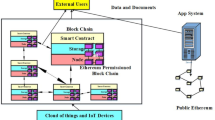Abstract
Quantum computers are considered to have the ability to change the landscape of data security in near future. In recent years, progress on this matter showed us that quantum computers can solve certain computational problems significantly faster than classical computers. Some firms or organizations claim to have constructed the world’s most powerful quantum computer, which is far more powerful than today’s classical computers. So, the concerning fact is that, the most secure ledger, blockchain now is facing critical issues of privacy and security. Cryptographic hash is one of the strongest tools in the cryptographic arena that is used in blockchain applications for confidentiality. However, cryptographic hash is certainly breakable under quantum computing because of Grover’s and Shor’s algorithm. To make a secure blockchain for sensitive medical data, we have to move into post-quantum blockchain. Under these circumstances, the proposed signature scheme is based on the combination of two SHA-3 finalists (Keccak-512 and Skein-512) and Merkle tree which will be suitable for blockchain technology. By exploiting the structure and properties of sponge function, Skein-512, and Merkle tree, the proposed scheme can achieve a certain benchmark of security and flexibility. Moreover, the proposed signature scheme can easily adopt the existing blockchain applications under the cloud environment.
Access this chapter
Tax calculation will be finalised at checkout
Purchases are for personal use only
Similar content being viewed by others
References
2018 CES: Intel Advances Quantum and Neuromorphic Computing Research
A Preview of Bristlecone, Google’s New Quantum Processor
Shor PW (1994) Algorithms for quantum computation: discrete logarithms and factoring. In: Proceedings 35th annual symposium on foundations of computer science. IEEE, pp 124–134
Fedorov AK, Kiktenko EO, Lvovsky AI (2018) Quantum computers put blockchain security at risk
Fleischmann E, Forler C, Gorski M (2008) The Twister hash function family. Submission to NIST
Hey T (1999) Quantum computing: an introduction. Comput Control Eng J 10(3):105–112. Publisher: IET
Arute F, Arya K, Babbush R, Bacon D, Bardin JC, Barends R, Biswas R, Boixo S, Brandao FG, Buell DA, Burkett B (2019) Quantum supremacy using a programmable superconducting processor. Nature 574(7779):505–510. Nature Publishing Group
Voorhoede D, Code example: Grover’s algorithm
Rodenburg B, Pappas SP (2017) Blockchain and quantum computing. Technical Report. The Mitre Corporation
Bogomolec X, Underhill JG, Kovac SA (2019) Towards post-quantum secure symmetric cryptography: a mathematical perspective. Cryptology ePrint Archive
Fernández-Carames TM, Fraga-Lamas P (2020) Towards post-quantum blockchain: a review on blockchain cryptography resistant to quantum computing attacks. IEEE Access 8:21091–21116 (2020). IEEE
Fernández-Caramés TM (2019) From pre-quantum to post-quantum IoT security: a survey on quantum-resistant cryptosystems for the Internet of Things. IEEE Internet Things J 7(7):6457–6480. IEEE
van der Linde W, Schwabe P, Hülsing A, Yarom Y, Batina L (2018) Post-quantum blockchain using one-time signature chains. Radboud University, Nijmegen, The Netherlands, Technical Report
Muñoz MC, Moh M, Moh T-S (2014) Improving smart grid security using Merkle trees. In: 2014 IEEE conference on communications and network security. IEEE, pp 522–523
Chenchev I (2019) Security improvement in a modified merkle-tree: computation and storage comparison between different cloud providers. In: Proceedings of the 9th balkan conference on informatics, pp 1–6
Keccak Team
Ferguson N, Lucks S, Schneier B, Whiting D, Bellare M, Kohno T, Callas J Walker J (2010) The skein hash function family. submission to the NIST SHA-3 competition (Round 3)
Hanser C (2012) Performance of the SHA-3 candidates in java. University of Technology, Institute for Applied Information Processing and Communications Graz
Dahal RK, Bhatta J, Dhamala TN (2013) Performance analysis of SHA-2 and SHA-3 finalists. Int J Cryptograph Inf Secur (IJCIS) 3(3):720–730
Alshaikhli IF, Alahmad MA, Munthir K (2012) Comparison and analysis study of SHA-3 finalists. In: 2012 international conference on advanced computer science applications and technologies (ACSAT). IEEE, pp 366–371
Hammad BT, Jamil N, Rusli ME, Zaba MR (2017) Double length sponge construction DLP-sponge. Int J Secur Appl 11(8):45–57. Publisher: SCIENCE & ENGINEERING RESEARCH SUPPORT SOC RM 402, MAN-JE BLDG, 449-8 OJUNG
Dworkin MJ (2015) SHA-3 standard: permutation-based hash and extendable-output functions
Acknowledgements
The ICT Division, Government of the People’s Republic of Bangladesh, contributed a portion of the funding for this research.
Author information
Authors and Affiliations
Corresponding author
Editor information
Editors and Affiliations
Rights and permissions
Copyright information
© 2022 The Author(s), under exclusive license to Springer Nature Singapore Pte Ltd.
About this chapter
Cite this chapter
Sultana, T., Mazumder, R., Su, C. (2022). Post-quantum Signature Scheme to Secure Medical Data. In: Kaiser, M.S., Mahmud, M., Al Mamun, S. (eds) Rhythms in Healthcare. Studies in Rhythm Engineering. Springer, Singapore. https://doi.org/10.1007/978-981-19-4189-4_9
Download citation
DOI: https://doi.org/10.1007/978-981-19-4189-4_9
Published:
Publisher Name: Springer, Singapore
Print ISBN: 978-981-19-4188-7
Online ISBN: 978-981-19-4189-4
eBook Packages: Intelligent Technologies and RoboticsIntelligent Technologies and Robotics (R0)


